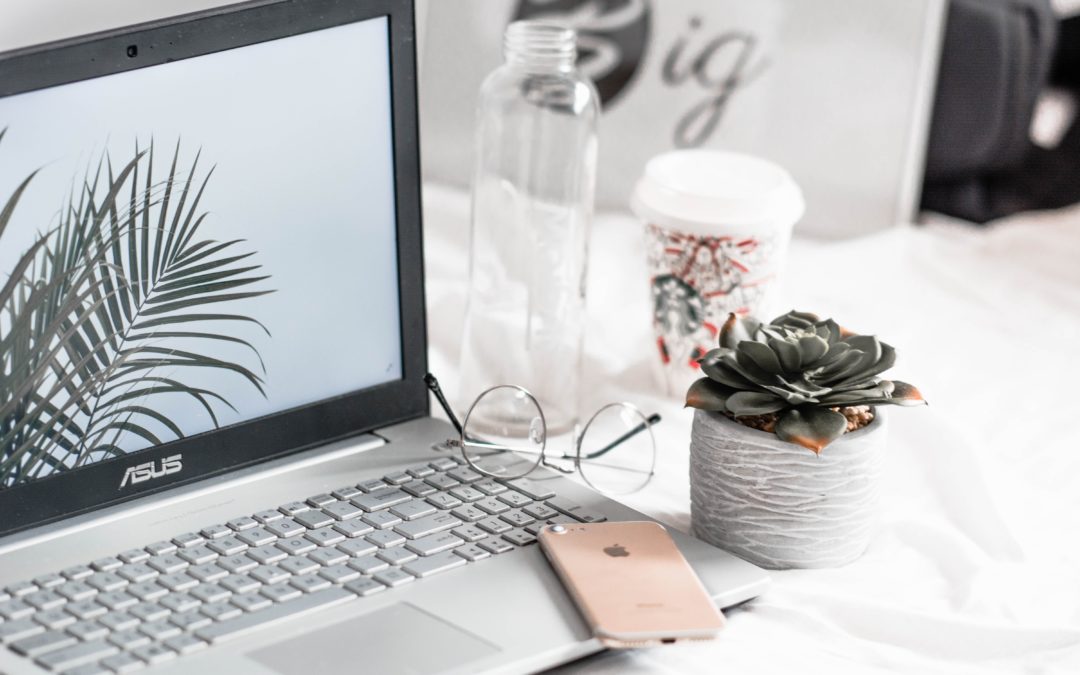Screens seem necessary right now. They have become our primary way to connect to loved ones, keep up with the news, manage learning for our children, entertain ourselves, and continue working (for working remotely). Without tech and media, life during the COVID-19 pandemic would feel very different. Screens are linked to both our stress and our sanity at the moment.
However, the quality and quantity of your screen time is really important to examine closely. As the Mayo Clinic shares: “Screen time impacts adults the same as children. Overuse of screen time puts everyone at risk of obesity, is linked with sleep disturbances and can impact relationships. Additionally, for kids—especially teens—there are studies concerning the negative impacts of screen time as it relates to anxiety, depression and attention span in school.”
Even prior to the pandemic’s onset the American Academy of Pediatricians recommended that parents place consistent limits on screen time for children, based on age. These guidelines were rooted in concerns about the long-term impact of screen time on developing brains. However, these recommendations were created prior to our current situation. So how can we embrace the gifts that modern technology offers, take into account expert advice, and create guidelines that really work for all of us during the pandemic?
To begin with it can be useful to reframe how we think about our media. As we distinguish between junk food and healthy food, so can we think about healthy screen time versus unhealthy screen time. Screen time includes television, iPads, computers, phones and gaming devices. Healthy screen time could be: video-chatting with family and friends, experiencing culture, learning new skills online, doing work or schoolwork, exercising with online videos, relaxing by meditating with an app, engaging educational media, or watching a show that helps us to unwind. Defining unhealthy screen time is a bit more complicated.
Catherine Price, author of How to Break up with Your Cell Phone, recommends that right now we should be defining unhealthy screen time based on how it makes us feel, rather than how many hours we are looking at screens. I would add that it can also be helpful to look at what we are doing with our media and screen time. Eight hours of watching The Good Place is not equal to eight hours of work for your job. One hour of scrolling through Instagram is different from a Zoom dinner date with your best friend. However, in all of those scenarios you are sitting down and looking at a screen for a long time. Questions to begin asking after being in front of a screen: How do you feel afterwards? How is your focus and your sense of satisfaction? What best supports your mental well-being? By getting curious and paying attention you can optimize how your technology works for you.
This is a really important inquiry as most apps and technology companies design programs to specifically capture and hold our attention. The more time we spend in an app, the more money its parent company makes. Your attention is not just valuable to tech giants. How you choose to spend your time greatly influences how you feel: your moment to moment choices truly are your most powerful medicine. Another component of “unhealthy screen time” is simply what we are not doing because we are looking at screens. The American Academy of Child and Adolescent Psychiatry defines good health and development practices for children as spending most of the day engaging social and family connections doing physical activity, schoolwork, and chores; reading for enjoyment, and sleeping. I think this holds true for adults as well. Screen time begins to have unhealthy effects on everyone when it keeps us from doing the basic activities that best-support our health and well-being.
While we need our phones and computers right now, it is so important to be intentional about how and when we use them. How can we increase our sense of connection, satisfaction, and safety? The stress and challenges we are currently navigating offer an opportunity to decide what healthy media habits look like and use them towards resourcing ourselves to navigate what is uncertain and hard. To help you begin this assessment for yourself or your family, we have listed some tips and resources below.
Prompts and Guidelines for Creating Healthy Media Habits:
How does it make you feel? How do you actually feel physically, mentally, and emotionally after you have been working at the computer all day, have just checked the news, or scrolled through Facebook for an hour? If you have kids, make this a family discussion. How do each of you feel after interacting with screens and media? Your experience should direct how you structure your relationship to media and screens.
- When to limit use: The blue light screens emit interferes with melatonin production. Melatonin is the hormone that helps us both feel sleepy and get a good night’s rest. It is a good idea to have kids stop looking at screens two hours before bedtime. Adults, at least thirty to sixty minutes before lying down to sleep. It can also be helpful to decide on what your ideal time limit would be for each app
- Where to limit use: Create physical boundaries by having a place in your home that is a tech free zone. Charge your phone in the kitchen or living room instead of next to your bed, and consider a “phone drop” where all phones stay during meal times. It can be helpful to create “media free” play zones: a corner with puzzles, books, and art supplies to facilitate decompressing and having fun without screens. Ultimately, instituting physical boundaries helps you to be sure that you are consciously reaching for your phone.
- What type of use is beneficial? Considering healthy versus unhealthy screen time can be a helpful way to re-frame screen use. Just as we strive to have a good ratio/balance of healthy versus unhealthy foods so we can begin to think about screens in the same way.
- Healthy ways to use screen time:
-
- 1) Video-chatting: No, it’s not the same thing as being with loved ones in person; however, being able to see each others’ facial expressions offers a deeper layer of connection than just talking over the phone. Visually connecting can also help children have a greater sense of normalcy.
- 2) Experiencing culture: Did you know that the renowned Louvre art museum in France is offering free, virtual tours? Many orchestras, museums, and artists are offering online expositions and performances.
- 3) Education and learning: Yes, school moved online last spring. Yes, it is summer-time; however, there are many free online classes for both adults and children. Whether it is learning how to play an instrument or taking a free class online, picking up a new skill is one way to use time that is free because the pandemic has restricted the plans you otherwise would have had. If you have young children, have them watch educational videos instead of cartoons- Sesame Street offers a lot of resources online: https://www.sesamestreet.org, as does https://pbskids.org. Sit down with them for a few minutes to talk about what is going on in the screen; this helps to bring connection and more learning into their screen time.
- 4) Movement: Dance, yoga, barre, HIT—you will find a great assortment of these video options throughout the web. If you do not have a compelling medical reason to not exercise, using YouTube to do a zumba class is a great idea. Exercise boosts immune function and lowers anxiety. It is a fantastic way to cope with stress, as long as it is not the only way you cope with stress.
- 5) Relaxing without avoiding: Having fun and decompressing is important. Watching SNL episodes or a great movie can be an effective way to sit back and relax. However, it can be easy to slip into binge-watching T.V. shows or over-reading the news. Try to find a balance between having some fun T.V. watching time and turning off screens to play cards, chess, or a board game.
- Create a plan. If you are single, decide on a screen time goal that best supports you feeling connected and less stressed. An example might be: “I will only look at screens between 8:00 am – 8:00 pm, and I will pick one family member or loved one to reach out to every day.” If you have kids, decide on a family media plan. If they are old enough, include them in this process. Here is an online rubric to help you get started, from the American Academy of Pediatrics. Use the guidelines and questions above to help you decide on what best supports you.
- Resources and Ideas to Support Healthy Screen Time:
- 1) Connection: Video-chatting is made easy by using apps such as Zoom, FaceTime, Facebook video, Google Meets, Marco Polo, and more.
- 2) Enrichment: So many arts, culture, and science related virtual tours are becoming available online. Zoos, museums, musicians, orchestras, and artists are offering online tours or live webcams. Here are a few to check out: The New York Orchestra, The Louvre in France, San Diego Zoo.
- 3) Learning: Taking up a new skill or building upon an existing one such as sewing, wood working, or playing an instrument is easy through free videos on www.youtube.com. Many top universities are also offering free classes through platforms such as https://www.coursera.org.
- 4) Movement: If you do not have a medical reason to abstain from exercise, it can be a great way to boost both your immune function and your mood. Online HIT https://www.fitnessblender.com/plans, dance classes, yoga, and more are available in video format—many are free!
- 5) Relaxation: Enjoying yourself and decompressing is really important. If you have a favorite T.V. show or a new movie you are excited to watch, great! Just be mindful about not having all of your relaxation come from screens. Watch a show, then take a break to read a book or play a card game.
This blog post was written by Ariana Figueroa, NBC-HWC, the Health Coach for Integrative Family Medicine of Asheville. You can learn more about Ariana by reading her bio!
- For more information, here are the sources we used for this blog post:
- 1) https://www.aacap.org/App_Themes/AACAP/Docs/resource_libraries/covid-19/Screen-Time-During-COVID.pdf
- 2) https://hms.harvard.edu/news/screen-time-brain
- 3) https://www.nytimes.com/2020/04/24/well/mind/screen-life-balance-computers-phones-quarantine-shelter-social-distancing-virus.html
- 4) https://www.screenagersmovie.com/tech-talk-tuesdays/when-they-know-they-are-being-manipulated-it-can-help?mc_cid=0f597ec245&mc_eid=1374e60879
- 5) https://www.screenagersmovie.com/tech-talk-tuesdays/the-myth-of-modeling-screen-time?mc_cid=c4b2e19a24&mc_eid=1374e60879
- 6) https://rogersbh.org/about-us/newsroom/blog/five-healthy-ways-use-screen-time-during-covid-19
- 7) https://connect.uclahealth.org/2020/04/03/how-parents-should-manage-childrens-screen-time-during-covid-19/
- 8) https://www.mayoclinichealthsystem.org/hometown-health/featured-topic/5-tips-for-reducing-screen-timehttps://onlinedegrees.unr.edu/online-master-of-public-health/screen-time-recommendations-for-students-parents-and-teachers/
-

